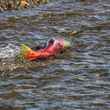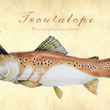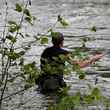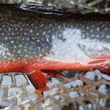This past weekend I spent time camping along the Beaverkill nestled deep in a fold of the Catskills. With no cell phone service I had the opportunity to get caught up on my reading in between a little trout fishing, socializing and relaxing with the family. In the stack of dead trees that accompanied me was Trout magazine. Trout was fairly high in the stack, well above the well recognized "how to" periodicals. During the past few years I've come to have a keener appreciation for the writers who are closer to the literary end of the spectrum than the "hook and bullet" end. The Drake, Flyfish Journal and Gray's Fly Fishing issue (though I feel it's aging out) are my new staples. Trout's in that class too though that's a fairly recent development.
I first met Kirk Deeter in 2012 shortly after he was announced as editor of Trout Magazine. Kirk's vision for Trout, the in house magazine of Trout Unlimited, was to be of such high quality that folks would join TU just to get the magazine. That sounded awful ambitious.
A few months later I ran into Kirk again at TU's annual meeting. He handed me a copy of the latest issue just before it got dropped in the mail. It was the first copy that he had edited front to back and it was an interesting change of course most notably for the stunning front page - a black and white photo of a chinook salmon. But the changes ran deeper.
When you look back at the archives of Trout, you'll see a decidedly conservation bent to the subject matter in each issue. There's also lots of recognition for chapter and national efforts at conservation. It's expected and natural that TU's magazine would have this editorial priority but it made the magazine a bit dry. Of course there were bright spots. Christopher Camuto appeared regularly with powerful observations on the sport and Dave Whitlock's articles in each issue are instant classics. But so much of what has attracted me to TU, the angling and the passion that members have for the sport and the resource, wasn't a major component of the magazine’s editorial priorities. That was the case until the Winter 2012 issue.
As an editor Kirk engages in some fine storytelling with each issue. The Spring 2014 is a great example. Several writers contribute to a sequence of essays that build around the theme of native and wild fish. From Christopher Camuto's piece connecting Aristotle to this passion we have for fish with a birthright to a certain place, to Tom Reed's simple, elegant essay on finding native cutthroat in thin headwaters streams right on down to Jay Cassell's feature piece on the role of hatcheries in the angling equation, Kirk conducts a masterpiece.
What works
Damn fine writing. You're not going to learn the latest knot, the best new fly pattern or even the where the biggest trout/salmon/golden dorado can be caught within the pages of Trout. What you will find are some of the finest essays on the sport generated by a generation of writers you'll be reading for years to come: Christopher Camuto, Tom Reed, Bruce Smithhammer, Erin Block, Chris Santella, Monte Burke and more than a handful of other fine pens. The writing is familiar and powerful.
The photography is definitely up a notch. Not only is the photography within the pages of higher quality and presented with a finer sense of design than in the past, but the cover art has also taken a turn for the better. That black and white photo of a chinook on the Winter 2012 cover is iconic. The Spring 2014 cover was the best cover I've seen on any angling magazine. Ever. Tim Romano is a rare talent.
The price. If you're not a member you can join TU for half price, $17.50. It's a bargain compared to the $26 you'll pay for any of the other national magazines (individual prices may vary).
The archive. All past issues, way back to 2007 are available free to members online. I haven't seen any other publisher offer that.
What Doesn't
Honestly, there's not much in this category. I suppose the downside of joining TU just to get the magazine is that you're going to have to suffer the endless series of requests for donations. Yeah, that can be tiresome but money makes the magic happen and, if you're able, you should do your part.
The price. Yeah, I know I put it in both places. Regular membership to TU is $35. So, once they've got you hooked you're paying more than any other magazine. Of course, you're getting a whole lot more than just the magazine. You also get a stake in ensuring that cold, clean water is a greater part of your landscape for generations to come. That's not a bad deal after all.
Final Word
So, has Kirk achieved his vision? Not yet. But I don't think it's because the jury is out on the quality of each issue. I think it's simply a matter of trajectory. The talent that contributes to the story telling each issue makes this magazine worth reading and it's only a matter of time before you break down and join up.
Steve lives and fishes in western Connecticut. When not working on his spey cast he writes at sippingemergers.com and on dead trees for various magazines.































Comments